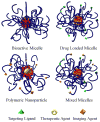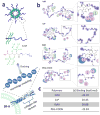Polymer-based therapeutics: nanoassemblies and nanoparticles for management of atherosclerosis
- PMID: 21523920
- PMCID: PMC3268460
- DOI: 10.1002/wnan.145
Polymer-based therapeutics: nanoassemblies and nanoparticles for management of atherosclerosis
Abstract
Coronary arterial disease, one of the leading causes of adult mortality, is triggered by atherosclerosis. A disease with complex etiology, atherosclerosis results from the progressive long-term combination of atherogenesis, the accumulation of modified lipoproteins within blood vessel walls, along with vascular and systemic inflammatory processes. The management of atherosclerosis is challenged by the localized flare-up of several multipronged signaling interactions between activated monocytes, atherogenic macrophages and inflamed or dysfunctional endothelial cells. A new generation of approaches is now emerging founded on multifocal, targeted therapies that seek to reverse or ameliorate the atheroinflammatory cascade within the vascular intima. This article reviews the various classes and primary examples of bioactive configurations of nanoscale assemblies. Of specific interest are polymer-based or polymer-lipid micellar assemblies designed as multimodal receptor-targeted blockers or drug carriers whose activity can be tuned by variations in polymer hydrophobicity, charge, and architecture. Also reviewed are emerging reports on multifunctional nanoassemblies and nanoparticles for improved circulation and enhanced targeting to atheroinflammatory lesions and atherosclerotic plaques.
Copyright © 2011 John Wiley & Sons, Inc.
Figures







References
-
- Libby P. Inflammation in atherosclerosis. Nature. 2002;420(6917):868–74. - PubMed
-
- McGill HC, McMahan CA. Determinants of atherosclerosis in the young. Pathobiological Determinants of Atherosclerosis in Youth (PDAY) Research Group. Am J Cardiol. 1998;82:30T–36T. - PubMed
-
- Lloyd-Jones D, Adams RJ, Brown TM, Carnethon M, Dai S, De Simone G, Ferguson TB, Ford E, Furie K, Gillespie C, Go A, Greenlund K, Haase N, Hailpern S, Ho PM, Howard V, Kissela B, Kittner S, Lackland D, Lisabeth L, Marelli A, McDermott MM, Meigs J, Mozaffarian D, Mussolino M, Nichol G, Roger VL, Rosamond W, Sacco R, Sorlie P, Stafford R, Thom T, Wasserthiel-Smoller S, Wong ND, Wylie-Rosett J. Executive Summary: Heart Disease and Stroke Statistics--2010 Update: A Report From the American Heart Association. Circulation. 2010;121(7):948–954. - PubMed
-
- Libby P. Coronary artery injury and the biology of atherosclerosis: inflammation, thrombosis, and stabilization. Am J Cardiol. 2000;86(8B):3J–8J. discussion 8J–9J. - PubMed
-
- Rubenstrunk A, Hanf R, Hum DW, Fruchart JC, Staels B. Safety issues and prospects for future generations of PPAR modulators. Biochim Biophys Acta. 2007;1771(8):1065–81. - PubMed
Publication types
MeSH terms
Substances
Grants and funding
LinkOut - more resources
Full Text Sources
Medical

